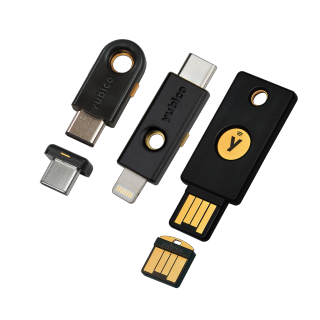YubiKey

A YubiKey is an inexpensive personal HSM produced by Yubico and widely used by large organizations such as the US Department of Defense, Facebook and Google.
Advantages
- Many protocols: Challenge/Response, FIDO U2F, TOTP, HTOP, GPG, SSH, etc.
- Configurable touch requirement for GPG operations
- Critical for limiting the actions of a remote actor on your sytem
- Form factor choices:
- YubiKey 5 Nano, 5c Nano
- NOT designed to be frequently removed (will damage it).
- Can be used on mobile devices via USB OTG
- YubiKey 5 NFC
- Fits on keychain, portable and suited for use with many systems.
- Sticks out of laptop which can be an issue for leave-in use cases.
- Can be used on mobile devices via NFC
- YubiKey 5 Nano, 5c Nano
Disadvantages
- Hardware design and Source code is not available for public auditing
- Information on supply chain integrity practices are not made public.
- Firmware can not be updated
- Entropy source is controlled entirely by Infineon
Verifying Authenticity
How do I know the YubiKey in front of me is actually a YubiKey from Yubico, and not from EvilCo?
People have been here before, and Yubico has helped them support page
They tell you to go to the verification page: Verification Page.
Visual Inspection
Does it look like someone opened it up and put in a MITM microcontroller?
If so, don’t use it.
OTP Verification
USB Way
You can use the official Yubico OTP Verification page to verify your device (although this does require you to insert an unverified HID into your computer).
NFC Way
For the YubiKeys with NFC, there’s a slightly easier solution that works ‘in the box’ so to speak.
You can scan the NFC with your phone through the sealed package and it will generate an NDEF payload containing an unused AES OTP token at the end of a verification url.
In other words, you scan one and it takes you to a yubico website saying it is legit, which is a decent verification.
WebAuthN Verification
You can use the Yubico WebAuthN to verify your YubiKey
Goto the WebAuthN Yubico Demo Site and go through the flow of registering your device.
You should see a “Registration Completed!” page and something like this image
which shows that Yubico Verified your device. Don’t be afraid to be curious and
click on the “Show Technical Details” dropdown menu to learn more about what’s
happening ‘under the covers’.

PIV Attestation
Each YubiKey comes “pre-loaded from factory with a key and cert signed by Yubico”source
You can use this to attest that the key was generated in a Yubico factory.
For a detailed guide on the inner-workings of this attestation, review this blog post created from the magic of CCCAmp 2019.
Setup
Notes
Yubikey devices are assumed as they are the most common and often the cheapest. These steps will be mostly relevant to other devices with gpg smartcards.
If you -only- need WebAuthN support (2FA on websites) you do -not- need this guide.
The following is mostly for power users that want to control their own keys and use their personal hsm for encryption, decryption, code signing, screen unlock, ssh, etc.
Install required software
OSX
2FA GUI Only: https://developers.yubico.com/yubioath-desktop/Releases/
GUI + CLI Tools:
port install gnupg yubikey-manager yubico-piv-tool pinentry-mac
echo "pinentry-program $(which pinentry-mac)" >> $HOME/.gnupg/gpg-agent.conf
Windows
GUI Only: https://developers.yubico.com/yubioath-desktop/Releases/
GUI + CLI Tools:
C:\> choco install pip yubikey-personalization-tool gpg4win openssh
C:\> pip install --user yubioath-desktop
Linux
Arch
pacman -S gpg yubikey-personalization libu2f-host yubikey-manager \
yubikey-full-disk-encryption yubikey-touch-detector yubioath-desktop
Debian
$ sudo apt-get install yubikey-personalization gpgv2 pinentry yubikey-luks \
yubikey-manager libu2f-udev u2f-host
Ubuntu
$ sudo apt-get install yubikey-personalization gpgv2 pinentry \
yubioath-desktop yubikey-manager yubikey-luks libu2f-udev u2f-host
Set PIN
To proceed with GPG operations you must set user/admin pin codes for your key. It is strongly recommended these be different.
You will use the User pin day to day for things like SSH or GPG but you will only use the Admin pin in the event you lock yourself out or to change certain protected settings.
gpg2 --change-pin
> 3 # change Admin PIN
> 1 # change User PIN
Set Personal Details
You can optionally set the owner details of your key. There are pros and cons to this. Someone who finds it will know whose it is and have the ability to return it to you. They also may have unlimited time to try to extract a key from it.
Your choice here should depend on how confident you are in your key revocation story and the hardware protections of your chosen HSM.
All of these are optional.
gpg --card-edit
> admin
> name # your name
> url # personal or company url
> fetch # URL to fetch public key
> login # your login
> lang # preferred language
> sex # your gender
Set Human Interaction Flags
The following will enable security features on the Yubikey that are only relevant to engineers/developers and are not needed for browser-only workflows.
Yubikey 5 Series
Require physical touch for all key operations:
ykman openpgp set-touch sig fixed
ykman openpgp set-touch aut fixed
ykman openpgp set-touch enc fixed